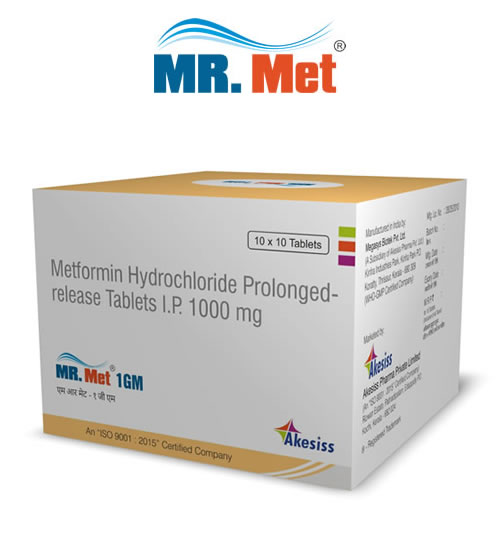COMPOSITION:
Mr.Met 500
Each uncoated bilayer (IPR) tablet contains
Metformin Hcl……….. 500 mg
Mr.Met 1000
Each uncoated bilayer (IPR) tablet contains
Metformin Hcl………….. 1000 mg
INDICATIONS:
Monotherapy for adults (above 17 yrs) with Type II Diabetes Mellitus as an adjunct to diet and exercise.
Concomitant therapy with sulfonylurea or insulin.
Management of PCOS.
DOSAGE AND ADMINISTRATION:
For the management of Type II Diabetes Mellitus uncontrolled by diet alone:
For monotherapy: Oral dosage – Adult: initially, 500 mg once daily with the evening meal. Increase in increments of 500 mg weekly, as needed, up to a maximum of 2000 mg once daily with the evening meal.
Elderly or debilitated patients: Same as adult dosage. Avoid use if > 80 years of age unless normal renal function is documented. In general, do not titrate to the maximum dose.
Switching to metformin from other antidiabetic therapy
Adults and elderly: When transferring from antidiabetic agents other than chlorpropamide, no transition period is required. When transferring from chlorpropamide, use caution during the first 2 weeks; there may be prolonged retention of chlorpropamide in the body, which may increase the potential for hypoglycemia.
Switching to extended-release metformin from immediate-release metformin:
No transition period is required. The patient receiving metformin immediate-release preparation may be safely switched to metformin extended-release at the same total daily dose.
Addition of a sulfonylurea or an alpha-glucosidase inhibitor to metformin
Adults and elderly: After 4 weeks of the maximum dose of metformin as described in monotherapy without adequate response, consider the gradual addition of an oral sulfonylurea, even if prior failure to a sulfonylurea has occurred. If after 1-3 months of concomitant therapy responses are unsatisfactory, consider insulin therapy and discontinuation of oral agents.
Addition of metformin in combination with insulin therapy:
Adults: The current insulin dose should be continued; initiate metformin dose at 500 mg at the evening meal. For patients not responding adequately, the dose of metformin may be increased by 500 mg after approximately 1 week and by 500mg/day every week thereafter until adequate glycemic control is achieved. The dose should not exceed 2000 mg/day. The insulin dose should usually be decreased by 10 – 25% when fasting plasma glucose decreases to < 120 mg / dl. Individualize the dosage of antidiabetic drugs as needed.
Elderly or debilitated patients: Avoid use if > 80 years of age unless normal renal function is documented. In general, do not titrate to the maximum dose.
Patients with hepatic impairment:
Generally, avoid metformin use in hepatic impairment; hepatic disease increases the risk of metformin-associated lactic acidosis.
Patients with renal impairment:
CrCl >=60 ml/min: No dosage adjustment required.
CrCl =< 60 ml/min: Metformin use is contraindicated.
For the management of polycystic ovarian syndrome (PCOS):
1.5 to 2.5 gm/day for 8-12 weeks (can be used throughout pregnancy in cases of PCOS with pregnancy).
CONTRAINDICATIONS:
Acidemia, acute myocardial infarction, breast-feeding, cardiogenic shock, diabetic ketoacidosis, hepatic disease, hypoxia, lactic acidosis/metabolic acidosis, renal failure, sepsis, surgery, radiographic contrast administration.
In patients with known metformin hypersensitivity.



